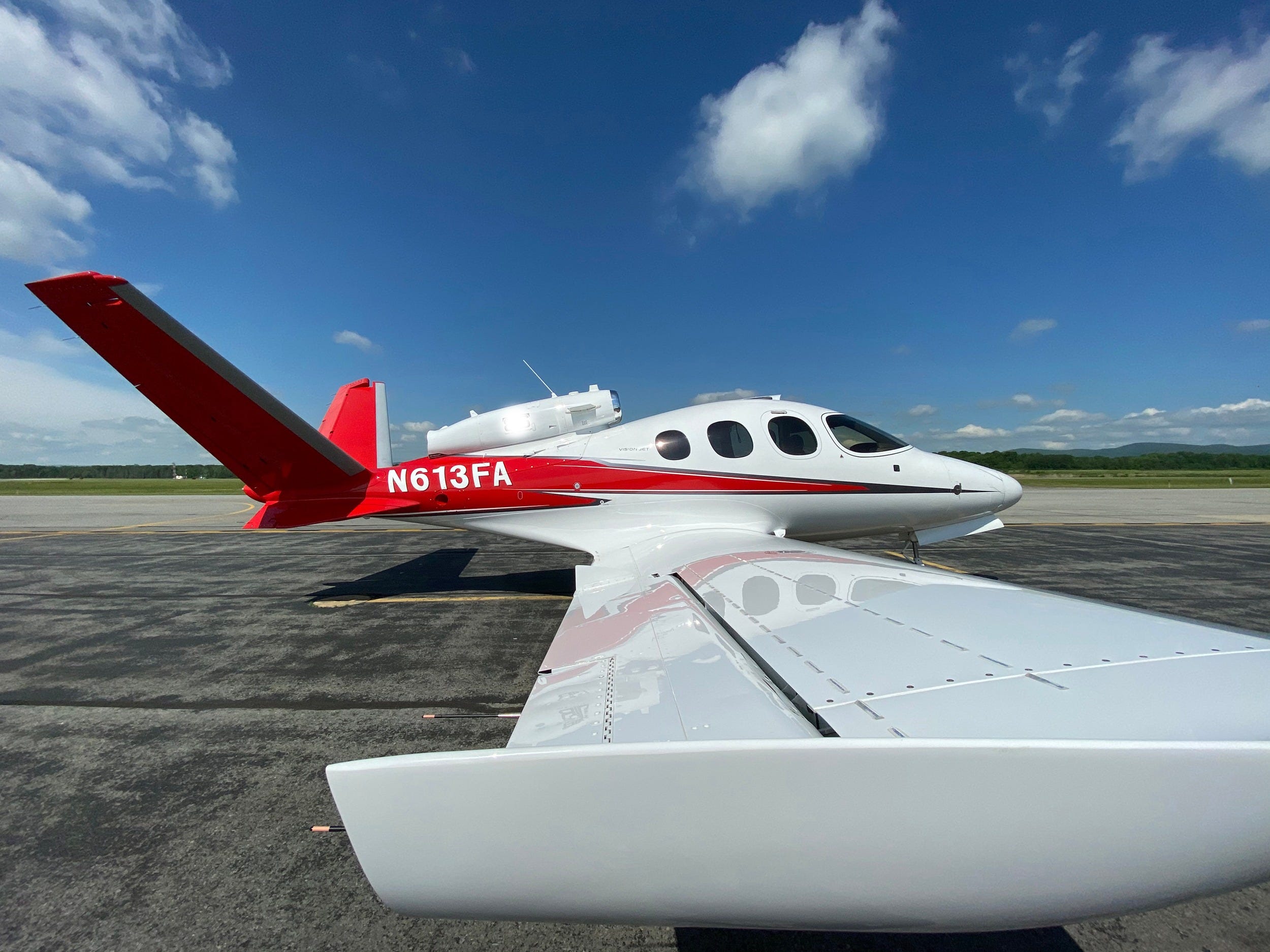- Personal private jets are intended to be flown by one pilot, often the owner, and are ideal for business, leisure, or a mix of both.
- Cessna has long dominated the single-pilot jet field with its line of Citation aircraft dating back to the 1970s.
- New designs from the likes of Cirrus, Embraer, and SyberJet aim to revolutionize the market with faster and simpler jets that don’t compromise on luxury.
- Visit Business Insider’s homepage for more stories.
One of the major takeaways from the coronavirus pandemic is a greater focus on independence and control, especially when it comes to travel.
When thousands of travelers saw flights being canceled en masse due to surprise travel restrictions, the only option for many was to cancel travel plans and some were even stranded overseas as a result.
While most are taking back control of travel by sticking to road trips or not traveling at all, one option for the wealthier jet setting public is personal private jets. Unlike traditional private aircraft, these tiny planes are meant to be flown by a single-pilot, often the owner, and are known for their ease of use even when flying in complex airspace.
General aviation has long been a bastion of independence for pilots but these planes take it to the next level, with the speed, range, and carrying capacity only jet aircraft can provide over pistons and even the newest turboprops.
Traveling businessmen who would travel around in piston Bonanzas are now able to upgrade to the newest jets from the likes of Cessna, Embraer, and Cirrus. And instead of loading up the station wagon for a long road trip, a family can load up the jet and be on the other side of the continent in a matter of hours.
Take a look at the best personal private jets.
The Cessna Citation

Cessna has long been the leader in single-pilot jet aircraft, with multiple models in its popular Citation line-up built with solo operations in mind. The light jet aircraft have dominated the skies since the 1970s with Cessna continuing production of new models nearly five decades later.
The smallest jet in the Citation line-up is the Mustang, a five-seater aircraft with a range of around 700 nautical miles and a cost price of $3.5 million, according to Business Jet Traveler. Cessna sold just under 500 Mustangs before retiring it from its product line.
Newer aircraft like the Citation CJ4 boast all the benefits of a light jet with a range greater than some airliners. Cessna puts the range of the CJ4 at just under 2,200 nautical miles, enough to fly from Phoenix to New York if the tailwinds are right, with a sticker price just shy of $10 million, according to Business Jet Traveler, and maximum capacity for 10.
Jim Hagedorn, the CEO of Scott's Miracle-Gro, commutes from Long Island, New York to Columbus, Ohio, according to Forbes, and back in a Citation nearly every day. The 500-mile trek takes about an hour with Hagedorn flying the plane himself.
The Cirrus Vision Jet

Cirrus debuted the Vision Jet in 2016 as the next step up from its popular piston product line with a price tag of around $2 million for a base model. The manufacturer crafted the jet with a similar feel to its piston aircraft so that pilots can train on the latter and graduate to the former when ready with a two-week training course.
The jet seats seven in a maximum capacity configuration with optional add-ons include SiriusXM Satellite Radio and WiFi. Unlike its competitors, the Vision Jet only has one engine, lowering its operating and maintenance costs and allowing pilots to fly it without multi-engine training.
The jet only offers around 800 nautical miles of range with a near-300 gallon fuel capacity so transcontinental trips will incur multiple fuel stops. In the event of an engine failure where landing safely isn't an option, the jet comes with a standard-issue parachute, a staple of Cirrus aircraft.
Business Insider recently went for a demonstration flight on the aircraft and saw firsthand its impressive capabilities.
The Eclipse Jet

New Mexico's One Aviation builds the Eclipse Jet, which can seat six. Though with a similar look to the Cirrus Vision Jet, the Eclipse Jet is just a bit longer and features two engines, which adds to its operating costs and requires users to have multi-engine training.
The price for one of the newer model six-seaters new is around $3 million, according to Business Jet Traveler, and in return, the jet offers around 1,100 nautical miles of range, according to the manufacturer. The Eclipse Jet can also climb to a top altitude of 41,000 feet, so high that the curvature of the Earth is visible.
A next-generation variant to the Eclipse Jet family is in the works which will see the range increased to 1,400 nautical miles and a new avionics suite in the cockpit, according to the Aircraft Owners and Pilots Association.
The Embraer Phenom

Embraer has been expanding its line of private jets in recent years with the smallest among them being the Phenom series including the Phenom 100 and Phenom 300. The smaller Phenom 100 can seat seven in a high-density configuration that includes using the lavatory and co-pilot seat as passenger seats while the larger Phenom 300 can seat 10 passengers, both not including the pilot.
Phenoms are high-performance aircraft with the Phenom 300 being able to reach speeds of Mach .80, which Embraer says makes it the fastest single-pilot aircraft. The duo can also reach cruise speeds of over 400 knots or greater than 460 miles per hour.
The Phenoms are popular with charter operators and are some of the largest private jets that can be flown by just one person. The jets feature modern, touchscreen cockpits as well as passenger-friendly features such as an enclosed lavatory.
The HondaJet

The HondaJet is one of the more unique private planes on the market that can be flown in a single-pilot configuration. Two variants of the product line are offered, the HondaJet and HondaJet Elite, with the later offering greater performance and range at a price of $5.25 million, as Business Insider found on a tour of Honda's newest aircraft.
Four passenger seats can fit in the passenger cabin, along with an enclosed lavatory, and the co-pilot seat can be used as a passenger seat when in a single-pilot configuration. One of the unique aspects of the HondaJet is that its engines are mounted over the wing and separated from the fuselage, which the manufacturer says improves efficiency.
The HondaJet has a range of around 1,200 nautical miles with four passengers on board, making transcontinental hops possible with just one stop. A cool feature for passengers is a "speaker-less stereo," where transducers vibrate the cabin walls for an immersive listening experience.
The Pilatus PC-24

The Pilatus PC-24 capitalizes on the success of the highly versatile PC-12 turboprop, another single-pilot aircraft, but adds on the speed of a jet aircraft. It's the first jet from the Swiss manufacturer and is growing in popularity in the US as it's currently in use with fractional ownership operator PlaneSense, as Business Insider's David Slotnick experienced on a demonstration flight.
The jet has a range of 2,000 nautical miles, according to its manufacturer, with seating for 11 in its most dense configuration, not including the pilot. It can also reach an altitude of 45,000 feet, where traditional business jets from Gulfstream, Dassault, and Bombardier aircraft can be found roaming.
One of the PC-24s most popular features is its short take-off and land capabilities and its ability to access airports that normal jet aircraft cannot, giving it the moniker of "super versatile jet" or SVJ. The Australian Royal Flying Doctor Service uses the jet to reach remote destinations in the outback with the PC-24 offering the unique capability of landing on unpaved runways.
The Raytheon Beechcraft Premier 1

Initially produced in the early 2000s, the Premier is the only true single-pilot jet to come from Beechcraft, which is also behind some of the most popular business jets such as the Hawker 800 and Beechjet. With room for six club chairs in the cabin and the co-pilot seat up front, the Premier can carry seven passengers when in a single-pilot configuration.
Though no longer being manufactured, the Premier was priced just under $6 million and offered the speed that other single-pilot jets at the time couldn't, according to the Aircraft Owners and Pilots Association. It was also built using composites at a time when few aircraft were.
The Premier had a range of around 1,100 nautical miles, according to the Aircraft Owners and Pilots Association, which also stated its top speed to be around 450 knots, roughly equivalent to 517 miles per hour. That meant trips from New York to Florida could be done nonstop but transcontinental hops might need two fuel stops.
The SyberJet SJ30i

The SyberJet SJ30i is slated to be the "world's fastest and longest range" light jet, according to the manufacturer, when it becomes fully certified. Currently undergoing test flights, the SyberJet promises a range of 2,500 nautical miles, enough to fly from Los Angeles to New York, at the speed of Mach .83, which would make it faster than the Phenom 300.
The jet can seat four passengers in the main cabin and one in the cockpit while also featuring a lavatory seat. Earlier versions of the jet failed to achieve commercial success but the latest version is hoping to change that with the first production aircraft planned for late 2020. according to Aviation International News.

